Norwich Cropper Pigeon: Regal Breed Guide
The Norwich Cropper, a breed of domestic fancy pigeon, is a fascinating and visually stunning avian species, mostly well-known for its distinctive characteristics.
This amazing avian beauty is the result of many years of selective breeding, especially bred for showcase and ornamental purposes. However, you can pet them as well because of their tame nature.
Curious to know more about this bird? Well, look no further.
In this brief guide, we will explore the Norwich Cropper’s history, features and everything about its successful breeding practices. So, let’s get started.
Norwich Cropper Pigeon Profile
| Scientific Name | Columba livia domestica |
| Common Names | ✔ Boulant de Norwich ✔ Norwich kröpfer ✔ Gozzuto in Norwich ✔ Норвичский Дутыш |
| Origin | Netherlands/ UK |
| Size | Medium to Large |
| Weight | 425 to 455 grams |
| Lifespan | 7 to 10 years |
| Physical Features | Plain-headed, red-orange or bull eyes, large inflated crop, narrow wings, short tails and cleaned legs |
| Temperament | Gentle |
| Behavior | Well-behaved, very friendly and social |
| Special Features | ✔ Elongated Inflated crop ✔ Erect Standing |
| Breeding and Maintenance | ✔ Easy breeding ✔ Low maintenance required |
| Common or Popular Varieties | ✔ Black ✔ Blue barred ✔ Red ✔ Red barred (mealy)Yellow ✔ Yellow barred (cream) ✔ Silver ✔ Self-white |
Interested in similar topics on pigeon breed:
Overview
The Norwich Cropper pigeon are also known by the names of Boulant de Norwich, Gozzuto in Norwich, Norwich kröpfer and ‘Норвичский Дутыш.‘ These names vary from county to county and region to region.
English writer Lyell first mentioned this amazing creature by its present name, which is “Norwich Cropper”. He also said that this bird was even older than the very famous “English Pouter”.
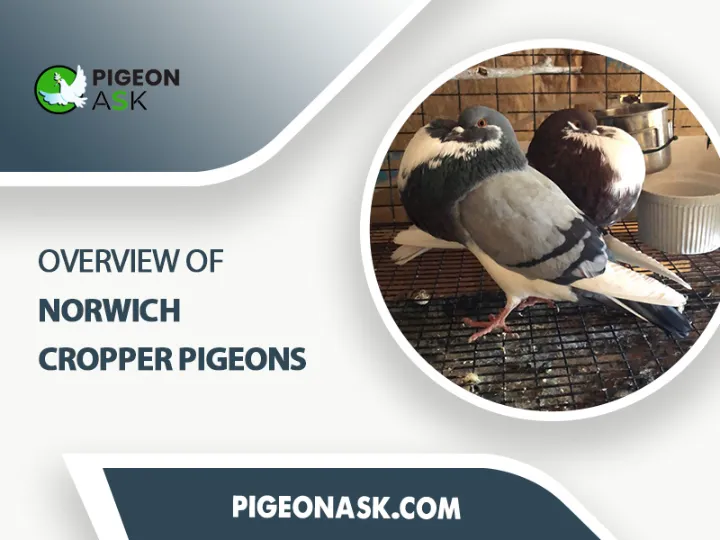
The main reason for breeding Norwich Cropper is to exhibit it in different shows. Plus, pigeon enthusiasts also use this pigeon for ornamental purposes and as a lovely pet.
With its aristocratic presence, elegant plumage and remarkable aerial acrobatics, the Norwich Cropper Pigeon has earned a place of distinction among pigeon fanciers and avian enthusiasts.
History And Origins of Norwich Cropper Pigeons
Like many other domestic pigeons, the Norwich Cropper is the descendent of the Rock Pigeon or Rock Dove (Columba livia).
It was developed in Suffolk, Norfolk and Essex by a group of fancy breeders.
They wanted a breed that would have not only the ability to be a good flyer but also the amazing appearance to win the pigeon lovers and eventually become the champion of the exhibitions.
Though the early history of the Norwich Cropper pigeon is pretty unclear, it is mentioned as one of the ancient races (16th century or earlier).
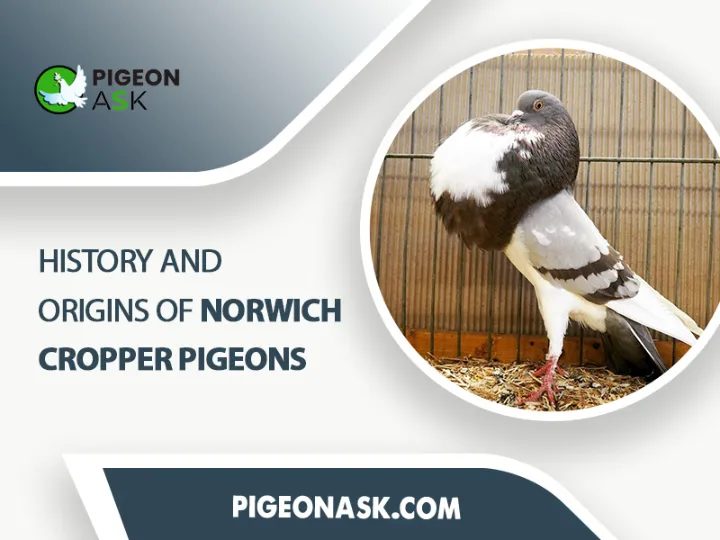
Plus, it is believed that the Norwich Cropper is of Dutch origin and has been developed from the Oploper.
However, according to a report by Axel Sell (Germany), Norwich cropper pigeons have a close link with the infamous Horseman Pouter.
The University of Utah organized a study where 70 pigeon breeds, including Horseman Pouter, were analyzed.
The Horseman Pouter were grouped together with other Pouters such as the Pomeranian Pouter, Norwich Cropper, and Racing Homer.
The study shows that with a genetic distance of only (Dest 0.015), the Pomeranian Pouter has the smallest genetic distance with the Horseman Pouter, followed by the (0.023) and (0.026) are Norwich Cropper and the Racing Homer.
Physical Characteristics And Features
The Norwich Cropper Pigeon can be found in medium to large sizes. Their weight ranges from 425 grams or 14.9 ounces to 455 grams or 16.05 ounces.
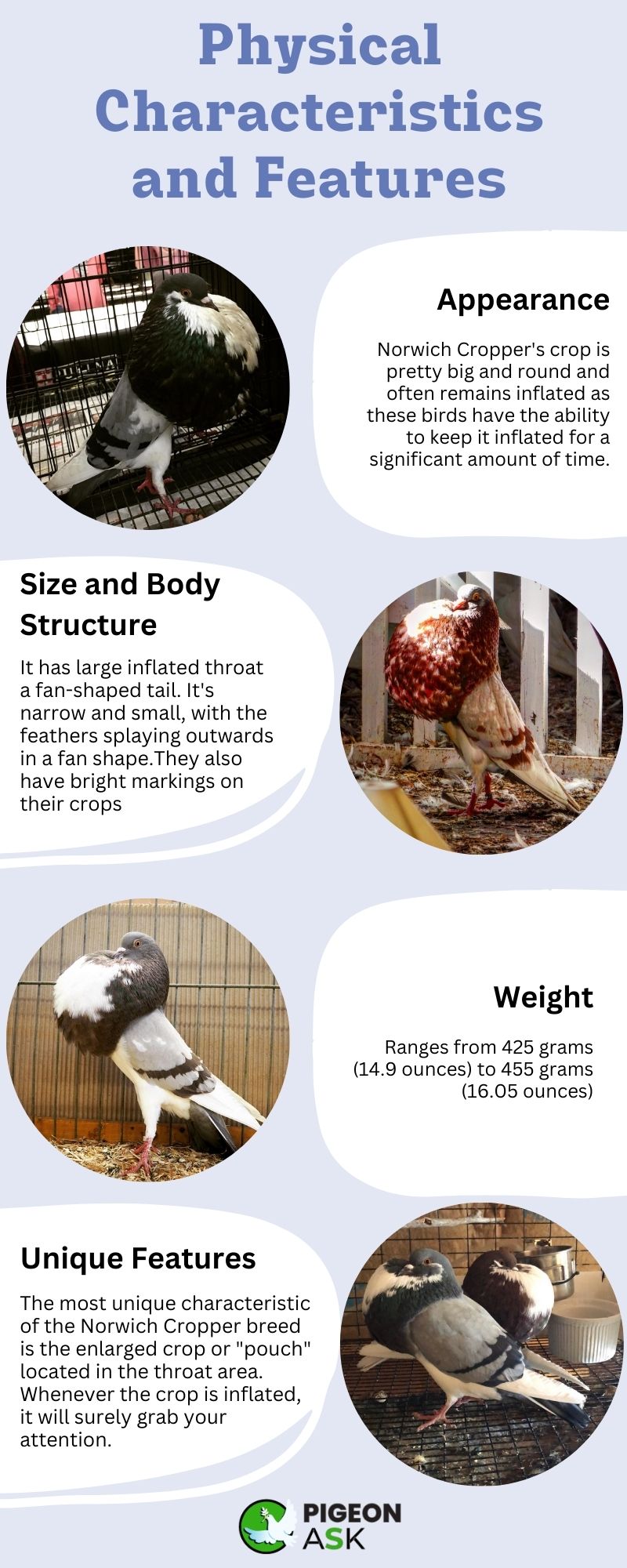
However, let’s have a closer look at their physical characteristics and other features.
Physical Characteristics and Features at a glance –
| Characteristics | Description |
|---|---|
| Height | Approximately 15 inches (38 centimeters), smaller than an English Pouter but larger than a Pigmy Pouter |
| Weight | Ranges from 425 grams (14.9 ounces) to 455 grams (16.05 ounces) |
| Size | Medium to large-sized pigeons with a well-proportioned, compact, and balanced body structure |
| Head | Plain heads |
| Eyes | Red-orange in color; white Norwich Croppers may have bull eyes |
| Colors | ✔ Black, blue barred, red, red barred (mealy), yellow, yellow barred (cream), silver, and self-white. ✔ Each variation exhibits distinct plumage hues and patterns, contributing to their striking appearance |
| Personality Traits | Recognized for their inflated crop or “Pouch” and distinctive posture on tiptoes, contributing to their unique appearance |
| Purposes | Bred for exhibition and ornamental purposes due to their unique appearance and varied color patterns |
Appearance
These adorable birds possess a graceful appearance. They stand on their tiptoes while keeping their body steep. It seems like they maintain a monarchial look and attitude while walking.
Norwich Cropper’s crop is pretty big and round and often remains inflated as these birds have the ability to keep it inflated for a significant amount of time.
These pigeons have plain heads and their eyes are often red-orange in color. But sometimes, the white Norwichs have bull eyes, giving them a distinctive look among the species.
Plus, the eyes have a bold look because of a waxy thread-like fleshy covering at the base of their upper beak. Overall, the Norwich Cropper boasts a striking appearance.
Size and Body Structure
Norwich Cropper pigeons have well-proportioned bodies. The compact and balanced body structure provides an elegant but hardy appearance.
With a well-arched neck, well-developed chest and well-held posture, they exhibit a harmonious proportion.
The wings of this pigeon are medium in length and remain close to the body. The feathers of the body are shiny, stiff, and well-fitted, especially in the vent and thigh areas.
Tails of the Norwich Cropper pigeons carried high, not touching the ground. Plus, their legs are sturdy and have no feathers covering them positioned in the center of their smooth, slender body.
Their average body height is about 15 inches or 38 centimeters, which is comparatively smaller than an English Pouter and more significant than a Pigmy Pouter.
Unique Features
The most unique characteristic of the Norwich Cropper breed is the enlarged crop or “pouch” located in the throat area. Whenever the crop is inflated, it will surely grab your attention.
And how can we forget about the standing posture on their tiptoes?
All these features can be quite pronounced, which ultimately gives the bird a unique and eye-catching appearance.
Some Common Variations in Colors and Markings
You see, Norwich Cropper Pigeons exhibit a range of captivating colors and markings. All these diversities contribute to their unique appearance.
Here are some common colors and marking variations found in Norwich Cropper Pigeons—
- 01. Black – These Norwich Cropper Pigeons are considered classy ones that display feathers that are predominantly black, portraying a sleek and elegant look.
- 02. Blue Barred – Some Norwich Cropper Pigeons have blue barred feathers, characterized by bluish-gray plumage with distinct bars or stripes. This adds a striking pattern.
- 03. Red – Red Norwich Cropper Pigeons showcase warm reddish-brown hues on their feathers, providing a vibrant and eye-catching look.
- 04. Red Barred (Mealy) – These pigeons feature a mottled or speckled pattern over their reddish-brown feathers. It creates an intricate and visually appealing appearance.
- 05. Yellow – Norwich Cropper Pigeons with yellow coloring exhibit bright and varying shades of yellow plumage, which adds a touch of vividness to their overall outlook.
- 06. Yellow Barred (Cream) – Yellow-barred Norwich Cropper Pigeons have a yellow base color with distinct bars or markings, much like their blue-barred counterparts.
- 07. Silver – With a silvery-gray coloration these pigeons possess an elegant and shimmering appearance.
- 08. Self-White – Some Norwich Cropper Pigeons are predominantly white with minimal or no markings, presenting a clean and pristine aesthetic.
Distribution And Habitat
Fancy breeders have created the Norwich Cropper as a domestic bird by years of selective breeding. Usually, you will not find them in the wild or in nature.
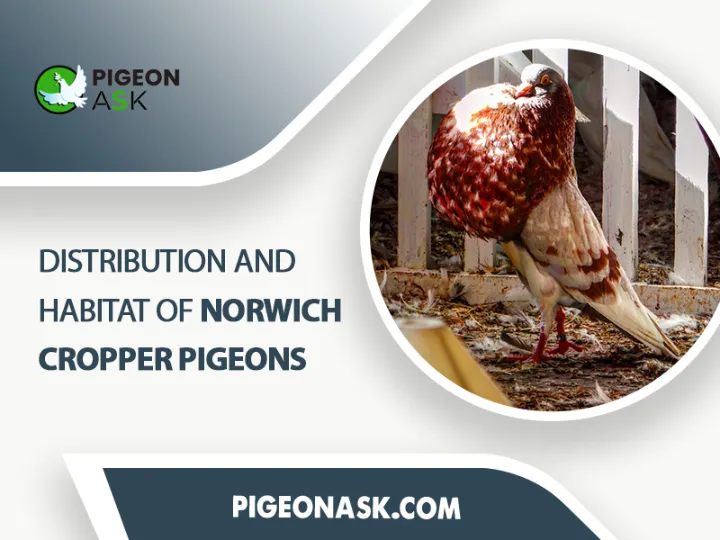
So, where can you find them and what are the habitual preferences of these pigeons?
Geographic Distribution
Norwich Cropper Pigeons originated from the UK, particularly from the Norfolk and Norwich regions, but they are mostly found in England, the Netherlands, and other European countries.
However, nowadays, their beauty and influence have extended beyond the homeland. They are found in captivity wherever enthusiasts and breeders around the world maintain populations of this unique breed.
Habitat Preferences
Norwich Cropper is home-bred and adapted to living in captivity. This pigeon doesn’t have any specific natural habitat preferences because of its domestic nature.
And it thrives in controlled environments like pigeon lofts, aviaries and dovecotes where it would receive care, protection from predators and nourishment from you or their human caretakers.
Urban and Rural Habitats
These pigeons are found in a wide range of environments, including urban, suburban and rural settings. But you will often spot them in the urban and suburban areas or where most fancy breeders exist.
However, pigeon enthusiasts may establish lofts or aviaries in rural settings depending on their preferences and available space.
In most scenarios, you will discover these birds in larger aviaries on private property in rural areas where fancy pigeon breeders may breed this pigeon in a larger quantity.
Because of its keen awareness of surroundings, heightened sense of vigilance, and great adaptability to nature and seasonal change, Norwich Cropper is not only a well suited inhabitant of the countryside but also of the urban and suburban areas.
Migration and Seasonal Movements
Unlike many other wild species, Norwich Cropper pigeons do not undertake migratory or seasonal movements.
These beautiful avians are homely breeds, and their existence is confined to the human-controlled environment throughout the year and in different seasons.
Therefore, Norwich Croppers do not have any urge to migrate, as their well-being is consistently provided by their caretakers.
Threats and Conservation Status
Being a domesticated breed, the Norwich Cropper is not the subject of threats and conservation concerns as wild pigeon species.
Pigeon breeders who are committed to preserving and improving the breed manage the population of these beautiful birds.
Yet, these pigeons can face some challenges as they remain confined in their lofts most of the time.
So, what are the possible threats?
Diseases, parasites, predation, and harsh weather can be causes of their illness. Therefore, providing a well-built loft and regular disinfecting process can help you keep your bird safe and sound from any potential danger.
Behavior And Traits of Norwich Cropper Pigeons
In this section, we have covered the usual behaviors and personality traits of Norwich Cropper.
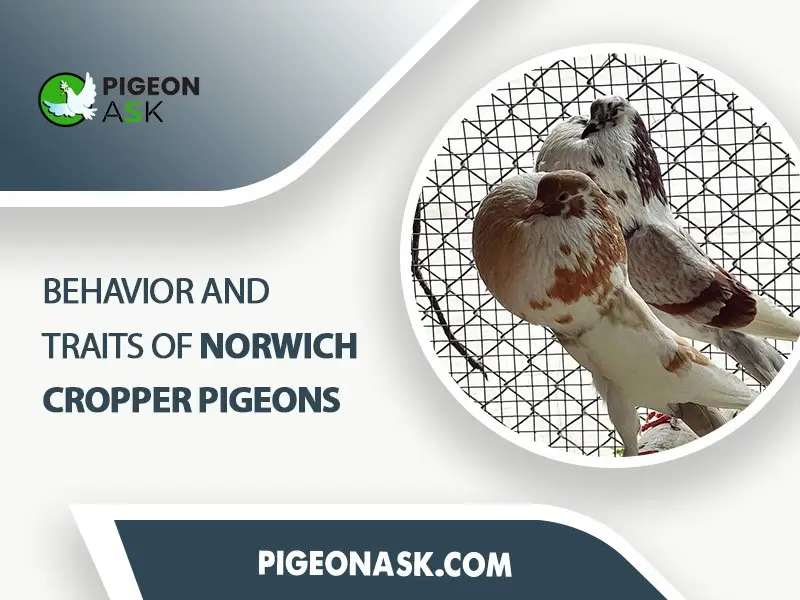
At a glance –
| Behavioral Traits | Description |
|---|---|
| Personality Traits | Calm, sociable, and gentle, enjoys human and pigeon company, easygoing, not aggressive |
| Diet | Grain-based diet, enjoys seeds, peas, balanced nutrition important, favors soft-leaf vegetables |
| Flight | Surprisingly skilled flier despite domestic breeding, can fly up to 15 hours, kite up to 1,500 ft due to physique |
| Nesting and Breeding | Good breeders in late winter, nest together, lay two eggs, hatch after 17-19 days, vigilant parenting for 4-6 weeks |
| Homing Instinct | Moderate homing instinct, can bond with caretakers through time and affection |
Common Personality Traits
Norwich Cropper Pigeons are well known for their calm and gentle nature. For a domestic setting, these birds can be an amazing option.
They are highly sociable and approachable. That’s why they often enjoy the company of other pigeons and breeds as well as their human caretakers.
Because of their delightful, tame nature, they do not engage in any aggressive activities and tend to be easygoing.
This makes them easy to handle and ultimately a great choice for pigeon lovers who want the Norwich Cropper as a pet.
Diet
Norwich Cropper pigeons like to feed on grains, cereal crops, plant seeds and peas. However, you can always offer a more balanced diet to ensure the nutrients supply to your Croppers.
Keep in mind a well-balanced diet often consists of a significant amount of carbohydrates (55-75%), protein (15-20%) and fat (5-10%).
Therefore, to meet the carbs requirement, you can add up some chopped vegetables along with the seeds.
But what type of vegetables do the pigeons prefer? Vegetables that have soft leaves, especially the Brassica family vegetables which include cauliflower, sprouts, broccoli and cabbage are the most loved ones.
Moreover, adding up some small insects and worms will help your Norwich Croppers with their Protein consumption.
Flight
Though the Norwich Cropper pigeon is a domestic breed and especially bred for exhibition, it has amazing flying capability.
This pigeon can fly for a longer period of time, approximately 15 hours and can kite up to 1,500 ft.
In this case, their lightweight physics and well-balanced compact body is a plus point to being a good flyer.
But as they are confined in lofts most of the time, you may not see their aerial prowess in a controlled environment.
Nesting, Breeding and Courtship
Most domestic breeds are naturally good breeders and the Norwich Cropper pigeon is no different.
Their meeting season starts in the late winter, and usually, the breeding process happens during the early spring and summer, when the weather remains mostly warm and sunny.
That’s not all, you also have to provide sufficient roaming area so that they can build their nest efficiently.
In general, when the pair finishes their nesting, the female Norwich Cropper lays two eggs. If the whole process goes on well without disturbance, the eggs will hatch after 17 to 19 days.
When do babies become independent? After 4 to 6 weeks of hatching, the Norwich Cropper babies start to live on their own but their parents still keep a vigilant eye on them.
Homing Instinct
As the Norwich Cropper is a domesticated bird, it has a natural homing instinct, though it might not be as strong as the racing pigeon breeds such as Racing Homer, Carneau, American Show Racer, Tape Turman, etc.
Nevertheless, this particular characteristic makes them extraordinary pets. Moreover, Norwich Cropper can build up a bond with you if you spend time around it and show affection with humble care.
Breeding And Maintenance
Paying keen attention to every major and minor detail is key if you are willing to breed the Norwich Cropper Pigeons successfully. To do it, check out our following recommendations.
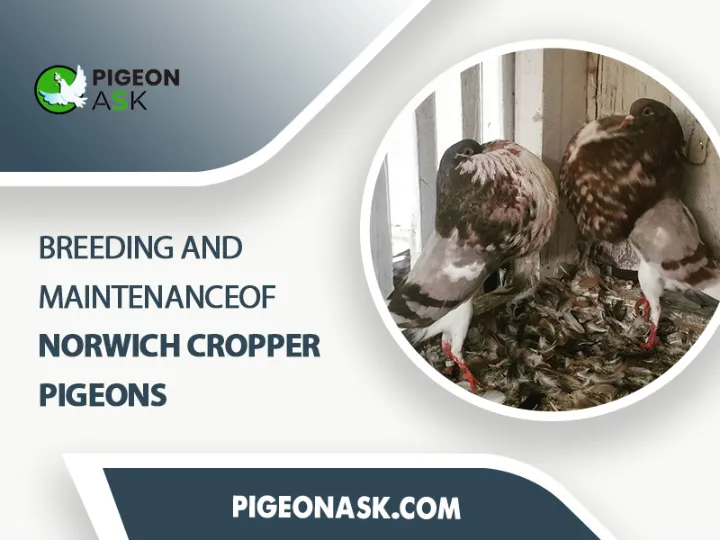
Information about Raising and Breeding
First of all, a perfect breeding practice depends on the proper timing. As the whole incubation, meeting and hatching process requires cozy and warm environments, summer or early spring is the perfect time to perform it.
Additionally, having a healthy and well-patterned baby mostly depends on the parent pigeons you choose.
Try to select a healthy and compatible pair and ensure they have the qualities and characteristics that you are hoping to see in the offspring.
Look for specific traits like a plain head, large crops, cleaned long legs, and a slender body. Make sure you are not mating pigeons who have flaws in them, like unusual shapes of heads, short legs, thick bodies, or narrow chests.
And to have visually appealing offspring, mate pairs who possess your desired coloring, markings, eye colors, and posture.
Thus, you will not only ensure the offspring quality but also get your desired features among the baby birds.
Oh! Let’s not forget about the nesting boxes or shelves. You must provide enough space for each pair and fill the nesting space with sufficient nesting materials to make the nesting and breeding process fast forward.
And remember to disinfect the nest regularly to prevent any vital diseases or parasites from spreading.
Some Tips and Considerations for Successful Breeding
Breeding Norwich Cropper Pigeons or any pigeon breed can be a rewarding but responsible endeavour.
Here are some tips and considerations for successful breeding—
- 01. Offer a balanced and nutritious diet that includes high-quality pigeon feed, grains, seeds and fresh water.
- 02. Give supplements if necessary, especially during breeding and chick-rearing periods.
- 03. Handle the eggs gently and do not rotate them excessively.
- 04. During the incubation time, keep any kind of disturbance at a minimum level.
- 05. Keep your eyes open for any signs of illness, injury, or unusual behavior.
- 06. Regularly monitor their health condition and maintain an accurate record of their breeding dates, parentage, or any specific details to track their development.
- 07. Join any local or online pigeon breeding communities to learn from an experienced breeder and stay updated about the best practices.
Feeding and Housing Requirements
Now, one of the most important things about breeding is to provide your Norwich Cropper with a proper dietary plan and housing.
You need to feed your lovely birds twice a day with a balanced diet, both in the morning and in the evening and give them easy access to wholesome food and clean water sources.
How Can you Create a Balanced Dietary Plan?
Well, keep the ratio at 50/50, meaning offer them the same amount of chopped veggies and high-quality pellets, seeds and grains. You can also add up some fruit options like berries, chopped carrots and potatoes.
Water should also be readily available consistently, ideally twice daily. Plus, change the water and leftover food from the food containers daily to prevent contamination.
Regarding Norwich Croppers’ lofts, you must give them bigger aviaries or lofts as they are pretty big compared to an average pigeon. But how big?
It should be big enough that your pigeons can spread their wings fully without any disturbance.
To keep each pair of your pigeons safe and to avoid any interference from other companies while incubation and breeding, do include nesting boxes or particular platforms in the housing system.
Lastly, you must arrange proper ventilation and keep the temperature (98.6°F to 100.4°F) and humidity level tolerable in the loft. Otherwise, the overall health of your pigeons can get damaged.
Final Word
Norwich Cropper pigeons are a captivating and unique breed cherished by pigeon enthusiasts all around the world.
Due to their distinct appearance, affable nature and adaptable traits, they have created a special place in the hearts of bird lovers.
However, by practicing responsible breeding, you can ensure the continued legacy of these remarkable birds for generations to come. So, best of luck and happy breeding.
That’s a wrap for today. We highly appreciate you for staying with us. If you find this article beneficial, feel free to follow us on our social media platforms Facebook, Twitter and Google News.
